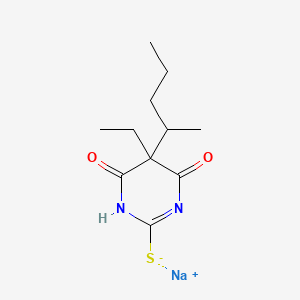



1. Bomathal
2. Nesdonal
3. Penthiobarbital
4. Pentothal
5. Pentothal Sodico
6. Sodipental
7. Thiomebumal
8. Thionembutal
9. Thiopental
10. Thiopental Nycomed
11. Thiopentobarbital
12. Thiopentone
13. Tiobarbital Braun
14. Trapanal
1. Sodium Thiopental
2. Sodium Pentothal
3. Thiopentone Sodium
4. Farmotal
5. Hypnostan
6. Leopental
7. Nesdonal
8. Ravonal
9. Penthiobarbital Sodium
10. Sodium Thiopentone
11. Thiomebumal Sodium
12. Pentothal
13. Trapanal
14. 71-73-8
15. Thiopentalum Natricum
16. Tiopental Sodico
17. Sodium Pentothiobarbital
18. Sodium Thiopentobarbital
19. Thiopental Sodique
20. Monosodium 5-ethyl-5-(1-methylbutyl) Thiobarbiturate
21. Sodium 5-ethyl-5-(1-methylbutyl)-2-thiobarbiturate
22. Pentothal Sodium-potassium Salt
23. Chebi:9561
24. Sodium (+-)-5-ethyl-5-(1-methylbutyl)-2-thiobarbiturate
25. Intraval Sodium
26. Nesdonal Sodium
27. Thiothal Sodium
28. Trapanal Sodium
29. Pentothal Sodium
30. Tiopental Sodium
31. Dsstox_cid_1744
32. Thiomebumalnatrium
33. Thiopenton-natrium
34. Dsstox_rid_76302
35. Sodium 5-ethyl-4,6-dioxo-5-(pentan-2-yl)-1,4,5,6-tetrahydropyrimidine-2-thiolate
36. Soluble Thiopentone
37. Dsstox_gsid_21744
38. Thiopentalum-natrium
39. Thiopentobarbitone Sodium
40. Thiopentalum Solubile
41. Sodium Penthiobarbital
42. Thiopental Sodium Salt
43. Tiopentale Sodico
44. Tiopentale Sodico [dcit]
45. Cas-71-73-8
46. 49y44qzl70
47. Tiopental Sodico [inn-spanish]
48. Thiopental Sodique [inn-french]
49. Nsc-759557
50. Thiopental, Sodium Salt
51. Thiopentalum Natricum [inn-latin]
52. Ncgc00159524-01
53. Einecs 200-763-1
54. Unii-49y44qzl70
55. Pentothal (tn)
56. Thiopental Sodium [usp:inn:jan]
57. 4,6(1h,5h)-pyrimidinedione, 5-ethyldihydro-5-(1-methylbutyl)-2-thioxo-, Monosodium Salt
58. 5-ethyl-5-(1-methylbutyl)-2-thiobarbituric Acid Monosodium
59. Chembl738
60. Schembl34621
61. Spectrum1900005
62. Dtxsid1021744
63. Hms503g07
64. Hms2094g03
65. Barbituric Acid, 5-ethyl-5-(1-methylbutyl)-2-thio-, Sodium Salt
66. Tox21_111741
67. Ccg-39536
68. Thiopental Sodium (jp17/usp/inn)
69. Akos025392174
70. Akos037653994
71. Tox21_111741_1
72. Ks-1432
73. Nsc 759557
74. Sodium 5-ethyl-5-(1-methylbutyl)-4,6-dioxo-1,4,5,6-tetrahydropyrimidine-2-thiolate
75. Ncgc00095773-01
76. Ncgc00159524-02
77. 4,6(1h,5h)-pyrimidinedione, 5-ethyldihydro-5-(1-methylbutyl)-2-thioxo-, Monosodium Salt, (+-)-
78. D00714
79. Q410179
| Molecular Weight | 264.32 g/mol |
|---|---|
| Molecular Formula | C11H17N2NaO2S |
| Hydrogen Bond Donor Count | 1 |
| Hydrogen Bond Acceptor Count | 3 |
| Rotatable Bond Count | 4 |
| Exact Mass | 264.09084324 g/mol |
| Monoisotopic Mass | 264.09084324 g/mol |
| Topological Polar Surface Area | 59.5 Ų |
| Heavy Atom Count | 17 |
| Formal Charge | 0 |
| Complexity | 346 |
| Isotope Atom Count | 0 |
| Defined Atom Stereocenter Count | 0 |
| Undefined Atom Stereocenter Count | 2 |
| Defined Bond Stereocenter Count | 0 |
| Undefined Bond Stereocenter Count | 0 |
| Covalently Bonded Unit Count | 2 |
Anesthetics, Intravenous
Ultrashort-acting anesthetics that are used for induction. Loss of consciousness is rapid and induction is pleasant, but there is no muscle relaxation and reflexes frequently are not reduced adequately. Repeated administration results in accumulation and prolongs the recovery time. Since these agents have little if any analgesic activity, they are seldom used alone except in brief minor procedures. (From AMA Drug Evaluations Annual, 1994, p174) (See all compounds classified as Anesthetics, Intravenous.)
Anticonvulsants
Drugs used to prevent SEIZURES or reduce their severity. (See all compounds classified as Anticonvulsants.)
GABA Modulators
Substances that do not act as agonists or antagonists but do affect the GAMMA-AMINOBUTYRIC ACID receptor-ionophore complex. GABA-A receptors (RECEPTORS, GABA-A) appear to have at least three allosteric sites at which modulators act: a site at which BENZODIAZEPINES act by increasing the opening frequency of GAMMA-AMINOBUTYRIC ACID-activated chloride channels; a site at which BARBITURATES act to prolong the duration of channel opening; and a site at which some steroids may act. GENERAL ANESTHETICS probably act at least partly by potentiating GABAergic responses, but they are not included here. (See all compounds classified as GABA Modulators.)
Hypnotics and Sedatives
Drugs used to induce drowsiness or sleep or to reduce psychological excitement or anxiety. (See all compounds classified as Hypnotics and Sedatives.)